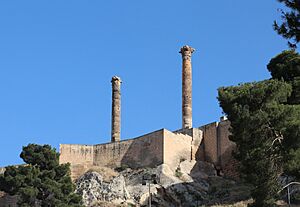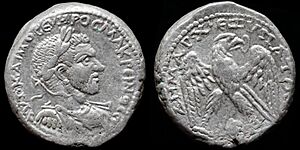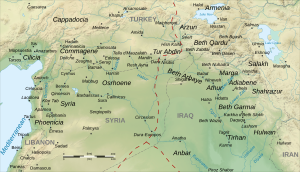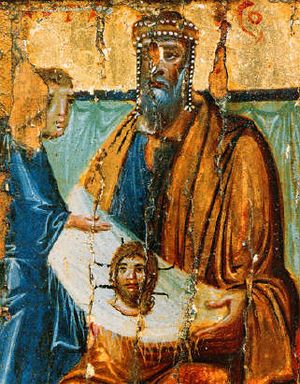Edessa facts for kids
Edessa was an ancient city in a region called Upper Mesopotamia. Today, this area is part of Urfa (also known as Şanlıurfa) in Turkey. The city was founded a very long time ago, during the Hellenistic period, by a Macedonian general and king named Seleucus I Nicator. He named it Edessa after an old capital city in Macedonia. The Greek name Édessa means "tower in the water," probably because of how much water was there.
Edessa later became the capital of the Kingdom of Osroene. It continued to be an important city when it became a Roman province. In later ancient times, it was a major center for Christian learning, famous for its Catechetical School of Edessa. During the Crusades, it was even the capital of the County of Edessa.
The city was built near the Daysan River, which flows into the Khabur River. It was protected by the Şanlıurfa Castle, a strong fortress on a high hill.
Modern Urfa (or Şanlıurfa) is the city that grew from ancient Edessa. The modern names likely come from the Syriac name Urhay or Orhay. After the Seleucid Empire was defeated, Edessa became the capital of the Kingdom of Osroene. This kingdom had a mix of Syriac and Greek cultures.
The Roman Republic started to influence Edessa and the Kingdom of Osroene around 69 BC. Edessa became a Roman city in 212 or 213 AD. Even then, local kings of Osroene ruled until about 243 or 248 AD. In later ancient times, Edessa was a key city on the border between the Roman and Persian empires. It successfully defended itself against attacks from the Persian king Shapur I in 260 AD. However, the Battle of Edessa in 260 AD was a huge disaster for Rome. The Roman emperor Valerian was defeated and captured alive by Shapur, which had never happened before.
Edessa was a center for Greek and Syriac ideas about religion and philosophy, home to the famous School of Edessa. The city stayed under Roman control until the Persians captured it in 609 AD. The Romans, led by Emperor Heraclius, took it back in 627-628 AD. But in 638 AD, the city was lost again to the Rashidun Caliphate during the Muslim conquest of the Levant. The Byzantine Empire (the Eastern Roman Empire) briefly got the city back in the mid-10th century.
The Byzantines regained control in 1031, but they didn't keep it for long. The city changed hands many times. The County of Edessa, one of the Crusader states formed after the First Crusade, was based here. The Crusaders took the city from the Seljuks. The county lasted until the Siege of Edessa in 1144. During this siege, Imad al-Din Zengi captured the city. Many people in Edessa were killed. The lands of Zengi's family eventually became part of the Ottoman Empire in 1517.
Contents
What's in a Name?

The very first name for this city was Admaʾ, which meant "red." This name was written in ancient Assyrian texts thousands of years ago.
Around 303 BC, Seleucus I Nicator rebuilt the old town as a military settlement. He named it Edessa after the ancient capital of Macedonia. He might have chosen this name because both cities had lots of water. Later, in the 2nd century BC, it was briefly called Callirrhoe or Antiochia on the Callirhoe.
After that, the city's name went back to Edessa in Greek. It also had names in other languages: Urha in Armenian, Urhay in Syriac, ar-Ruhā in Arabic, and Riha in Kurdish. The Latin name was Rohais. Finally, it became Urfa or Şanlıurfa (meaning "Glorious Urfa") in Turkish, which is its name today. The Syriac name might have come from the Persian word Khosrow.
During the Byzantine period in the early 6th century, it was renamed Justinopolis. Some old Jewish and Muslim stories say that Edessa is the location of Ur of the Chaldees, the birthplace of Abraham.
Where Was Edessa Located?
Edessa was built on a ridge, which is like a long, narrow hill. This ridge was surrounded by other hills and a flat, fertile plain. This made it a good place to live. The ridge was also connected to Mount Masius, which is part of the Taurus Mountains in southern Asia Minor.
The city was at a very important crossroads. A main road from east to west, going from Zeugma on the Euphrates River to the Tigris River, met a north-south road at Edessa. This north-south road went from Samosata to the Euphrates through Carrhae (modern-day Harran).
A Look at Edessa's Past
Ancient Times
In the second half of the 2nd century BC, the Seleucid Empire began to break apart. During this time, Edessa became the capital of the Abgarid dynasty. These rulers created the kingdom of Osroene, also known as Edessa. This kingdom was founded by Arabs from the northern Arabian Peninsula. It lasted for almost 400 years, from about 132 BC to 214 AD, with 28 different rulers.
At first, Edessa was somewhat protected by the Parthians, then by Tigranes of Armenia. Later, from the time of the Roman general Pompey, it was under the Roman Empire. The Romans even took control of Edessa from 116 to 118 AD after a Roman emperor named Trajan captured it. However, because Edessa often sided with the Parthians, another Roman general, Lucius Verus, attacked the city later in the 2nd century.
Christianity was present in Edessa by the 2nd century. A wise man named Bardaisan, who was born in Edessa, was a Christian philosopher at the king's court. From 212 to 214 AD, the kingdom of Osroene became a Roman province.

The Roman emperor Caracalla was killed near Edessa in 217 AD. Edessa then became a border city for the Roman province of Osroene, very close to the Sasanian Empire. The famous Battle of Edessa happened in 260 AD between the Roman army, led by Emperor Valerian, and the Sasanian forces under Emperor Shapur I. The Roman army was completely defeated and captured, including Emperor Valerian himself. This was a huge defeat for Rome.
The people who founded the kingdom of Osroene spoke Aramaic, which later developed into Syriac. Greek culture, which had been strong in Edessa, soon became less important. Edessa started using Syriac writing on its coins, except for King Abgar IX (179–214 AD). There were also very few public writings in Greek.
Edessa in Later Ancient Times
According to the Chronicle of Edessa, a historical record written after 540 AD, the main church in Edessa was built right after the end of the persecution of Christians in the Roman Empire, around 313 AD. This church was dedicated to Holy Wisdom. About 23 different monasteries and churches were known to exist inside the city, and many more just outside. These places attracted many visitors.
A writer named Eusebius of Caesarea even claimed that "the whole city" was "devoted to the name of Christ" in the early 4th century. However, the city still had some pagan and Jewish residents until the early 5th century.
Eusebius also said he found letters between King Abgar V and Jesus in the Edessa archives. These letters are part of the famous Abgar Legend.
Egeria, a Roman lady who traveled a lot, visited Edessa in 384 AD. She saw a shrine to Thomas the Apostle and the words of the Letter of Jesus written on the city walls. People believed these words protected the city. She saw a longer version of the letters than she knew before and was told that the holy words had stopped a Persian attack on the city.
According to the Chronicle of Edessa, the remains of Saint Thomas were moved to the great Church of St Thomas in 394 AD and placed in a silver box in 442 AD. A bishop named Gregory of Tours said that the remains had come from India. He also mentioned that an annual fair was held at the church in July to honor the saint.
The School of Edessa became very famous after Nisibis, another city, was given to the Sasanian Empire in 363 AD. A scholar named Ephrem the Syrian moved from Nisibis to Edessa and founded this school. Many Christian young people from Persia attended it. The school was very important for Christian learning. It was temporarily closed in 457 AD and finally in 489 AD. After that, its teachers and students moved to Nisibis.
Under the Sasanian emperor Kavad I, the Sasanids attacked Edessa. A shrine outside the city walls was burned by his troops.
Edessa was rebuilt by Emperor Justin I and renamed Justinopolis after him. A Greek historian named Procopius wrote that the words of the Letter of Jesus were written on the city gates, which made the defenses unbeatable.
The Sasanian Empire tried to capture the city again in 544 AD but failed. Edessa was taken by the Sasanian Empire in 609 AD, then retaken by Emperor Heraclius. But it was lost to the Muslim army in 638 AD during the Muslim conquest of the Levant.
Edessa: An Early Christian Hub
We don't know the exact date Christianity arrived in Edessa. But by 190 AD, Christianity was spreading quickly in Edessa and the areas around it. Soon after, the royal family joined the church.
An old story, first told by Eusebius in the 4th century, says that King Abgar V became a Christian because of Thaddeus of Edessa (also called Addai). Addai was one of the 72 disciples of Jesus, sent by Thomas the Apostle. However, other sources suggest that the King Abgar who became Christian was actually Abgar IX. Under him, Christianity became the official religion of the kingdom.
Addai was followed by other important Christian leaders. In the 2nd century, the famous Peshitta, a Syriac translation of the Old Testament, was created here. Also, Tatian's Diatessaron, a harmony of the four Gospels, was made around 172 AD and used widely until a bishop named Rabbula forbade its use. Among the famous students of the School of Edessa was Bardaisan (154–222 AD), who was a school friend of Abgar IX. He was important for creating Christian religious poetry.
A Christian council was held in Edessa as early as 197 AD. In 201 AD, a big flood destroyed the city, including the Christian church. In 232 AD, the remains of Thomas the Apostle were brought from India to Edessa. Many Christians were killed in Edessa under Roman rule, including Sharbel and Barsamya. Meanwhile, Christian priests from Edessa traveled to other parts of Mesopotamia and Persia, setting up the first churches in the Sasanian Empire.
As the main city of Osroene, Edessa had eleven smaller church areas under its control. Many bishops of Edessa are known from history.
Under Islamic Rule
An Armenian historian named Sebeos, writing in the 660s, gives one of the earliest accounts of Islam. Sebeos writes about a group of Jewish people going to an Arab city after the Byzantines took Edessa:
Twelve groups of all the Jewish tribes gathered in Edessa. When they saw that the Iranian (Persian) troops had left... The Byzantine Emperor Heraclius ordered the city to be surrounded (in 625 AD)... So they left, taking the desert road to the sons of Ishmael (Arabs). The Jews asked the Arabs for help and told them about their shared history from the Old Testament. Even though the Arabs believed they were related, they couldn't agree among themselves because they had different religions. At that time, a merchant named Mahmet, one of the sons of Ishmael, became important. A message about the Way of Truth, supposedly from God, was given to them... he told them all to gather and unite in faith... He said: "God promised that land to Abraham and his son forever. And what was promised came true when God loved Israel. Now, you are the sons of Abraham, and God will keep the promise made to Abraham and his son for you. Just love the God of Abraham, and go and take the land God gave to your father, Abraham. No one can defeat you in war, because God is with you."
Muslim traditions also tell a similar story. Sebeos's account suggests that Muhammad was leading a group towards Palestine, rather than a Jewish-Arab alliance against the pagans in Mecca.
Middle Ages
The Byzantine Empire often tried to take Edessa back. One time, under Emperor Romanos I Lekapenos, they got the "Image of Edessa" from the people. This was an ancient picture of Christ, and it was moved to Constantinople on August 16, 944 AD. This famous image, which was definitely in Edessa in 544 AD, was later stolen by the Republic of Venice in 1207 during the Fourth Crusade.
In 1031, Edessa was given to the Byzantines. But it was soon taken back by the Arabs. Then, it was held by the Romans again, then the Armenians, then the Seljuq dynasty (1087), then an Armenian named Thoros (who became independent from the Turks in 1094), and finally the Crusaders (1098). The Crusaders set up the County of Edessa there and held the city until 1144.
In 1144, Imad al-Din Zengi captured the city again. Many of its people were killed, including the Latin archbishop. We know about these events mostly from the Armenian historian Matthew, who was born in Edessa. In 1144, the city had 47,000 Armenian residents. In 1146, the Crusaders briefly took the city back but lost it again after a few days. A historian named Steven Runciman wrote that "the entire Christian population was forced to leave... the great city, which claimed to be the oldest Christian community in the world, was left empty and deserted, and has never fully recovered."
The Ayyubid Sultanate leader Saladin took the town from the Zengids in 1182. During Ayyubid rule, Edessa had about 24,000 people. The Sultanate of Rûm took Edessa in June 1234, but the Ayyubid sultan Al-Kamil got it back in late 1234 or early 1235. After Edessa was recaptured, Al-Kamil ordered its castle to be destroyed. Later, the Mongols arrived in Edessa in 1244. The city willingly gave itself up to the Ilkhanate (a Mongol kingdom) in 1260, which saved its people from being killed. Edessa was also held by the Mamluk Sultanate and the Aq Qoyunlu.
Later History
After these times, Edessa was controlled by the Safavid dynasty. From 1517 to 1918, it was part of the Ottoman Empire.
In 1518, under the Ottomans, Edessa's population was only about 5,500, likely because of wars between the Ottomans and Persians. By 1566, the population had grown to about 14,000. In 1890, Edessa had 55,000 people, with Muslims making up most of the population.
Famous People from Edessa
Edessa was home to many important writers and thinkers. The oldest known Syriac writings, from 411 and 462 AD, came from Edessa.
Here are some famous people connected to Edessa:
- Jacob Baradaeus: A strong Christian leader who helped keep the (Oriental) Orthodox church alive after difficult times.
- Jacob: A bishop of Edessa and a very productive writer (died 708 AD).
- Theophilus: An astronomer who translated Homer's Iliad and Odyssey into Syriac poetry.
- The person who wrote the Chronicon Edessenum (Chronicle of Edessa), a historical record from 540 AD.
- Thaddeus of Edessa: A Christian saint and one of Jesus's seventy disciples.
See also
 In Spanish: Edesa para niños
In Spanish: Edesa para niños



